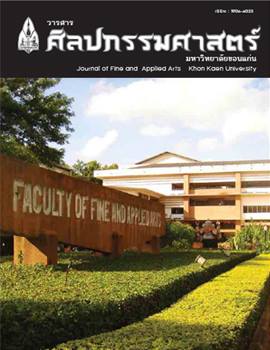การศึกษาภูมิปัญญาพื้นบ้านอีสานด้านการผลิต ผลิตภัณฑ์โลหะผสมสำริดและทองเหลืองเพื่อพัฒนามูลค่าเพิ่มเชิงพาณิชย์
Main Article Content
Abstract
When did humans first discover a metal? A clear answer to this question has not yet been found until now. However, it is believed that humans have already known and used metals since early periods such as gold, silver, and copper. Copper, in particular, has been used for making ornaments in simple forms until there has been accumulation of so great experiences in terms of metallurgy that humans can differentiate properties of each kind of metal, and can have better understanding of metalwork. This study aimed to examine history and developments of bronze and brass products; to investigate indigenous knowledge, and bronze and brass products; and to develop bronze and brass for adding commercial vales to producers in northeast Thailand. The sample consisted of a group of key informants, a group of practitioners, and a group of involved persons, obtained using the purposive sampling technique. The research instruments were formal and informal structured – and unstructured – interview forms, participant and nonparticipant observation forms, a note – taking form on group discourse, and a note – taking form on workshop seminar by working together with local metal casters. The collected data were analyzed by means of a descriptive analysis.
The results of the study revealed the following: Histories and development of bronze and brass products in northeast Thailand in the Prehistoric Age, the Historic Age, and the contemporary Modern Age did not have relationships or connection with each other in terms of ethnic group, thoughts, beliefs, and product models. However, there were lose relationships in terms of the production process, particularly the production process of substituting wax; and there were relationships with each other in terms of uses and product models. Indigenous knowledge could be divided into these a groups: 1) indigenous knowledge for selecting local natural materials, 2) indigenous knowledge in the production process, and 3) indigenous knowledge appearing in the product models. For guidelines for developing materials, the methods used were experimenting and testing new materials to originate a variety of material colors. The instrument used for examining colors was the spectrometer, and 24 colors of new material shades of bronze and brass were obtained to be used in product design. In terms of production process development, a new production process called “sand model casting” was used for simple products, and the production process of substituting wax with new materials for products with complex models, could reduce stages of production and could increase more production quantity than before. Development of designs could be divided into three groups: bass relief sculpture group, high relief sculpture group, and round relief sculpture group. The conceptual frameworks of designs used were obtained from Isan indigenous knowledge mixed with new technology as follows: bass relief products used the conceptual framework from indigenous knowledge of Isan khit cloth patterns; high relief products used the conceptual frameworks from indigenous knowledge of hit sip song or Isan people’s twelve months of the year; and round sculptures were products emphasizing mainly daily life uses.
In conclusion, the factors of success in production, and bronze and brass product for developing commercial values in northeast Thailand were still on bases of concepts and indigenous knowledge mixed with new concepts for integrating traditional concepts into new ones, particularly development of materials, production process and new commercial production models in order to increase values and costs of the products to be in accordance with needs of the community and consumers in the future.Article Details
Content and information in articles published in the Journal of Fine and Applied Arts of Khon Kaen University is regarded as the opinion and sole responsibility of the author(s) directly; therefore, editors are not obliged to agree to or share any responsibility with regard to the content and information that appears within these articles.
All articles, information, content, image, etc. that have been published in the Journal of Fine and Applied Arts of Khon Kaen University is the copyright of the Journal of Fine and Appllied Arts of Khon Kaen University. Any person or organization who wishes to distribute all or parts of the articles for further dissemination or other usage must first receive permission from the Journal of Fine and Applied Arts of Khon Kaen University before proceeding to do so.


